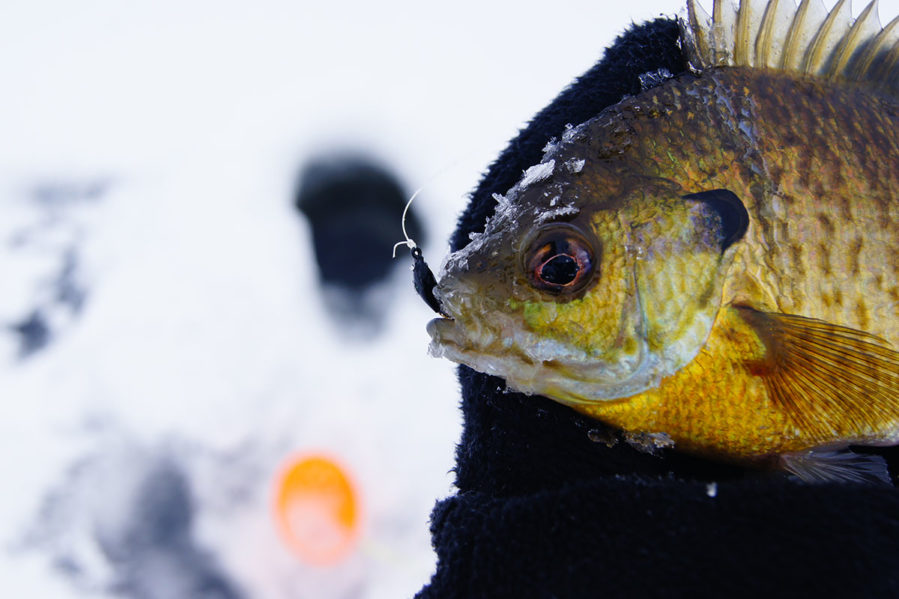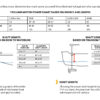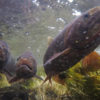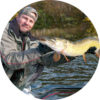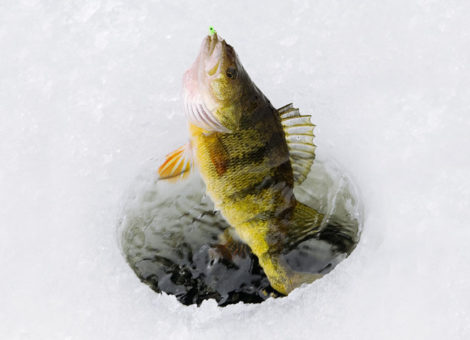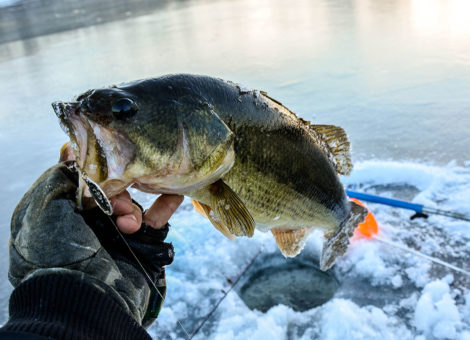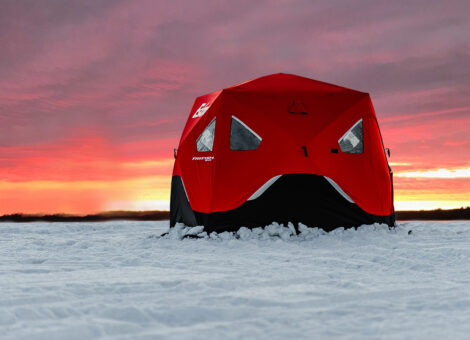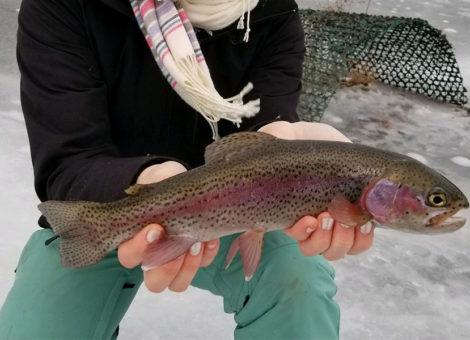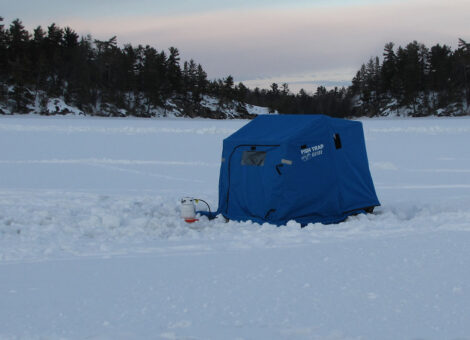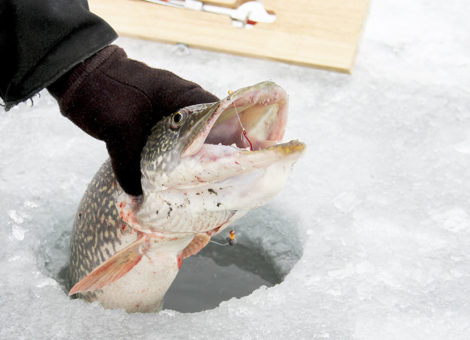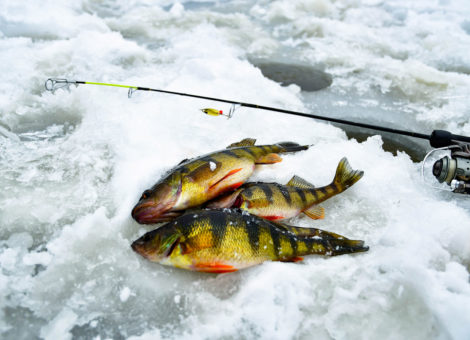Young or old, chances are the first fish most anglers will catch is a bluegill or bream. Bluegill fishing brings back memories of cane poles, a can full of worms, and an old ratty fishing dock on Lake Michigan for myself, and I’m picturing something similar for many of you as well. Bluegill are found in nearly all North American lakes, rivers, streams, and ponds, so it’s no wonder these fish are so well known amongst anglers. Catch enough of them the size of your hand, and you can also have yourself quite a tasty little fish fry as well.
Their extensive distribution and excellent taste makes ice fishing Bluegill a popular winter activity for anglers. Whether they are used as bait or as the main course, no one can deny that catching these little pancakes is a load of fun. Bluegill will strike a wide variety of lures and presentations and will take a bite on anything they can fit into their relatively small mouths. This voracious appetite and their predisposition to gather in large schools make them the perfect fish to target for all anglers of all skill levels.
- Bluegill Description
- Equipment for Bluegill Fishing through the Ice
- Tackle for Bluegill through the Ice
- Best Lakes for Ice-fishing Bluegill?
- Where do I find Bluegill on a Frozen Lake?
- Winter Feeding Habits
- Best Bait for Bluegill
- Best Artificial Lures for Bluegill
- Fishing methods
- Tips
The Bluegill Description
The Bluegill, also known as a bream, is in the family Centrarchidae, also shared by Largemouth bass and Smallmouth bass. These ray-finned fish can grow up to 15 inches long, and the world record weighed in at 4 pounds 12 ounces and was caught by T. Hudson in Alabama in 1950. Bluegill around 6-8 inches long are considered biggins, and anything more significant than that is cause for a celebratory “Whoop-whoop” by most anglers familiar with the pursuit of these flatties.
Bluegill are a staple part of the food chain in many lakes providing a feedstock for Bass, Walleye, Pike, Salmon and Muskie that rely on them as a food source throughout the year. These fish are typically caught around structures, drop-offs, vegetation, and boulders where they can feed and hide from predators. Through the ice, they become lethargic as their metabolism slows down, but they still are opportunistic feeders when food is presented within their vicinity. In fact, Bluegill is one fish that will bite all winter long.
General Equipment for Bluegill Fishing through the Ice
- Electric or gas-powered Ice Borer – Make your life easier, and never drill another hole manually again. Trust me. It’s worth every penny.
- Needle nose pliers or fish dehooker – to de-hook fish without taking off your gloves
- Small shovel or spade – to remove ice from the bore hole.
- Transducer – It’s always important to know your depth and what is underneath your feet when ice-fishing.
Tackle for Bluegill through the Ice
Suppose you have any ultralight ice-fishing tackle you want to break out for this year’s ice-fishing season. Now is the time to do so. Bluegill, though small, can put up an incredible fight on light tackle due to their unique body shape that catches water like a dinner plate as you attempt to pull them up through the water column.
- Rod – As light or as heavy as you want. You honestly can’t go too light when targeting Bluegill through the ice. The only thing to be aware of is you might hook something much larger than you bargained for if you use a large rod. Ultralight to light rods 18-30 inches in length are perfect for even the feistiest bluegills.
- Reel – A 1000 or a 2000-size spinning reel is perfect for Bluegill. The only reason to go larger is if you plan on fishing deep or in areas where larger predator fish may be lurking.
- Line – Believe it or not, Bluegill can sometimes be picky through the ice. I use low-profile fluorocarbon lines in the 2-6lb test range. Anything heavier, you will notice sharp declines in the number of bites you get.
Best Lakes for Ice-fishing Bluegill?
As mentioned, Bluegill have an incredibly wide distribution throughout the United States, Canada, and even some parts of South America, Europe, and Asia. However, if you want to travel this winter for your next Bluegill adventure, I recommend the following lakes.
- Lake of the Woods – Located near Ontario and Manitoba, this lake freezes thick and has some genuinely gigantic bluegill specimens pulled from its waters every year.
- Lake Winnebago – Easier to get to with solid fishing infrastructure, lake Winnebago is the perfect destination for Ice-fishing if you find yourself in the Midwest this winter.
- Lake Michigan – Or any of the great lakes are fantastic ice-fishing destinations. However, I would highly recommend a guide service if you plan on tackling this water body. There is just too much water to cover for a single trip.
- Private or Public Ponds – Nothing beats a well-managed pond for bluegill fishing through the ice. Simply locate the deepest part of the pond and drop a line in. Typically, the thermocline in the winter is around 8-10ft, so be aware that if the pond is too shallow, the fish might be even less active than usual.
Note: Where Bluegill lurk in the winter, so do their predators, i.e., Pike, muskie, largemouth bass, and Walleye. Know that all of the main lakes listed above contain these predators in large numbers, and they fall to feed on Bluegill.
Where do I find Bluegill on a Frozen Lake?
Bluegill can be somewhat challenging to find during the year’s colder months. Most of the shallow grass dies off and quickly becomes anoxic due to the decomposition of the organic matter. As this grass dies, the Bluegill must move off their cozy summer homes to deeper structures and vegetation below the thermocline. To find bluegill during winter’s cold look for the following:
- Structure – Structure can be tricky to find on lakes you are unfamiliar with. It is best to seek local knowledge or scout areas out during the year’s warmer months to find regions with sunken trees, logs, boulders, docks, or other underwater refuges for Bluegill. You can also use a topographical map or aerial photos to identify lake structure and likely spots where Bluegill will hold out.
- Vegetation – In the winter, green vegetation on a lake is like an oasis in the desert for many species of fish, predators, and prey alike. Bluegills are no exception to this rule and will use these grass flats to graze and hold up for the coldest months of the year. Typically, you can find these grass flats off the sides of points and other gradual changes in depth. In a lake full of Bluegill, find the vegetation and you’ll find Bluegill. If you’re unable scout out patches of vegetation prior to winter, use a topographical map of the lake to identify where there’s likely vegetation.
- Depth – A question on everyone’s mind, regardless of the species, is “how deep do I fish” and the answer is and always will be to the learned: “It depends.” On most frozen lakes, you can expect to find Bluegill anywhere from 8-20ft deep. The depth will fish will depend more on where vegetation and structure is located. During the mid-winter months when vegetation all but dies off, Bluegill tend to migrate to deeper waters with flat, soft bottoms where they can find aquatic insects and larvae to feed on.
Winter Feeding Habits
Bluegill are opportunistic feeders in winter but rarely venture off their chosen structure or habitat when the cold sets in. You can find them floating near these structures, lazily grazing on nymphs, worms, small crustaceans, and minnows that venture too far into the open. Sometimes schools of Bluegill will move up and down a grass flat throughout the day, but if you catch one, chances are you have found them all.
If something is too large for Bluegill to swallow in one gulp, it will take small bites out of it, lightly pulling it into and then expelling it from their mouths. Small hooks and small baits will improve your hook-up ratio. However, having an ultra-light, the ultra-sensitive rod will drastically improve your ability to perceive these subtle winter bites.
Best Bait for Bluegill
Many speculate on the best bait for Bluegill when, in reality, there are all different kinds of bait you can present to Bluegill to great success. The most important thing is cutting the bait small enough to fit into their mouths. Bread, corn, hotdogs, cut bait, chicken livers, shrimp, wax worms, night crawlers, crawfish, crickets, and minnows are all on the dinner table for these voracious little Frisbees.
- Mealworms and Waxworms – The wax worm is probably the most accessible bait to use for Bluegill. They keep well, don’t freeze, and you can fit a container of 100 of them in your jacket pocket.
- Nightcrawlers – If you are going to use nightcrawlers, be prepared to cut them into small palatable pieces for these lethargic discs of fish.
- Everything else – Bluegill are a great fish to experiment with regarding what bait they will and will not eat. Over the years, I’ve caught them on all the baits mentioned above, and I’m still discovering more and more. Remember, they are opportunistic and generally are not picky when it comes to a free meal…just make it look appetizing.
Best Artificial Lures for Bluegill
Small jigs and fly-fishing flies/nymphs are my go-to artificial lures for Bluegill in the winter. I have found that larger, flashy lures tend to spook away more Bluegill than they attract in cold water conditions. If I’m looking for those more aggressive bites, I will use small spoons or puppet minnows and tip their hooks with meal worms. Experimentation and adaptation on a day-to-day basis are key to catching more fish. As with all types of fishing, what works one day might not work the next day.
Fishing methods
Anglers deploy many different types of rigging to catch Bluegill through the ice. My personal favorite and probably the simplest is a 1/32 oz jig with a waxworm on the hook. If you don’t have any jigs, you can use a small hook baited with a waxworm or nightcrawler with a split shot about 6 inches above the hook to the same effect. Let the bait drop all the way to the bottom and jig the lure up and down the water column until you initiate a strike.
Once you have determined the general depth that the Bluegill are holding, you can use a slip bobber as a visual reference for a bite if you don’t feel like holding the rod anymore. The slip indicator allows the angler to slide the bait up and down without removing the indicator from the water. Bluegill will generally follow a bait up and down multiple times before actually taking a bite during the winter. The bite can be swift; Bluegill are notorious bait thieves.
In addition to jigging, tip-ups can be an effective method for ice fishing Bluegill. The biggest benefit of tip-ups is that they allow you to fish multiple locations at once. Set the tip-up and leave it. When the Bluegill bites, the tip-up will send a flag in the air letting you know you’ve got a fish on your line. To maximize the efficacy of fishing with tip-ups I recommend adding a much less visible 12-16” 6-lb monofilament or fluorocarbon leader to your line. Most tip-ups use a heavier, more visible line that can spook Bluegill. The lighter, less visible leader line will catch you fish.
Tips
- Drill, Drill, Drill – Drill as many holes as it takes to find them – Bluegill do not move very much once ice covers the lakes and typically won’t bother with food that is too far away. It’s best to find a location right next to them where they don’t have to expend too much energy or stray too far from safety for a meal. Drill multiple holes about 15′ apart. Once you zero in one where the Bluegill are biting, you can drill more holes nearby.
- Best Time to Fish – Because Bluegill are fed upon in the early morning and late evening hours of the day, typically, the best bite is late morning, midday, and early evening before the predator species become more active.
- Use light tackle – I know I mentioned you could use heavier tackle. Still, these fish pound-for-pound are incredibly scrappy, and to truly appreciate that tenacity, you need to have light enough gear. If you accidentally hook that 40in muskie…well, it’s a more extraordinary story if you land it on an ultralight. And again… I’ve found that Bluegill tend to respond better to lighter line.
Go catch em.
Suppose I’m looking to take a new angler ice-fishing or need some relaxation after a hard day of work. Nothing beats bluegill fishing through the ice. On the scales of Easy to catch vs Fun to catch, Bluegill fall right in the middle. They only require a little knowledge, and even the most basic of tackle will be enough to land a bucket full. Now get out there on the ice and hook yourself one of these scrappy little fish.


